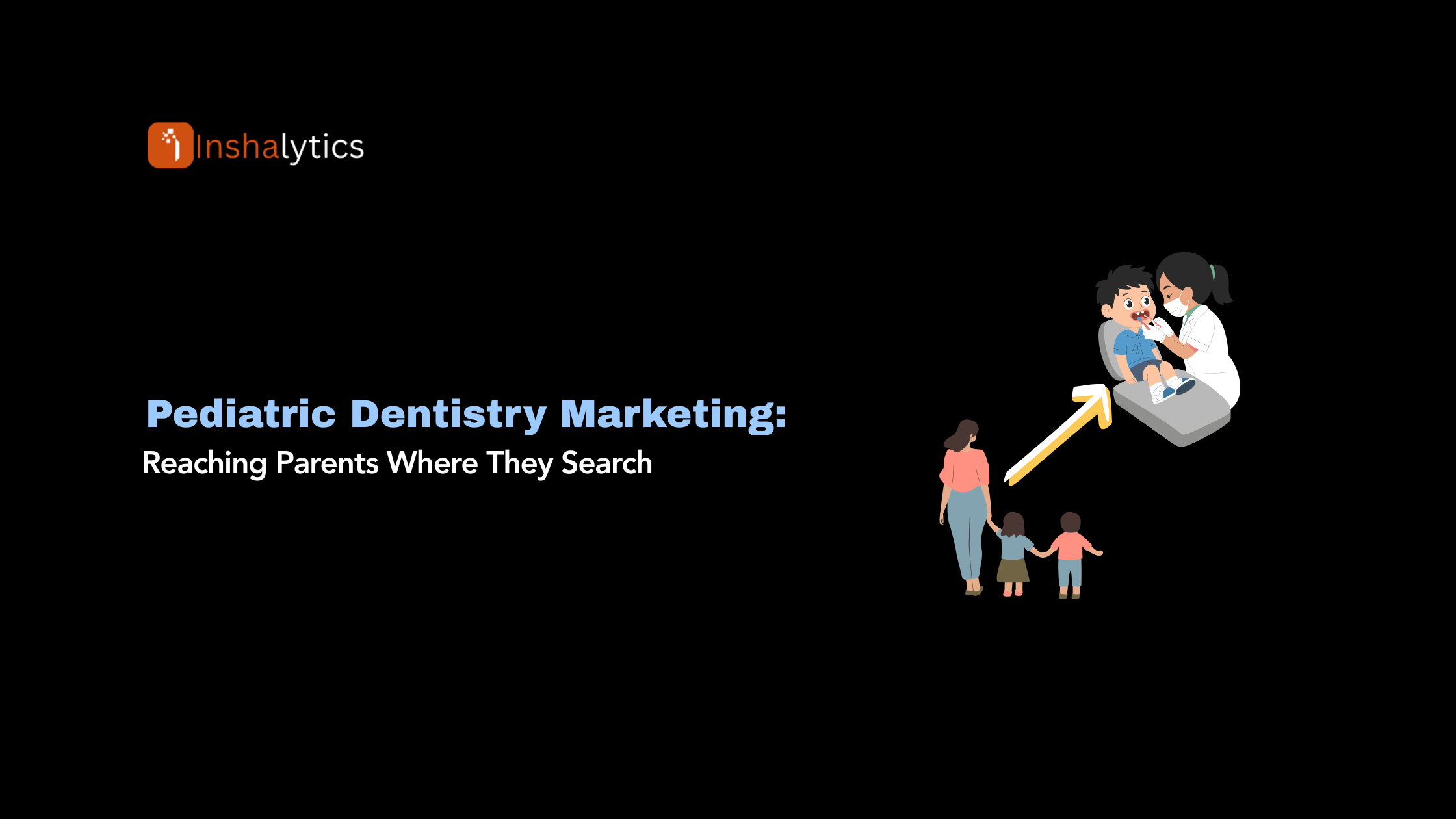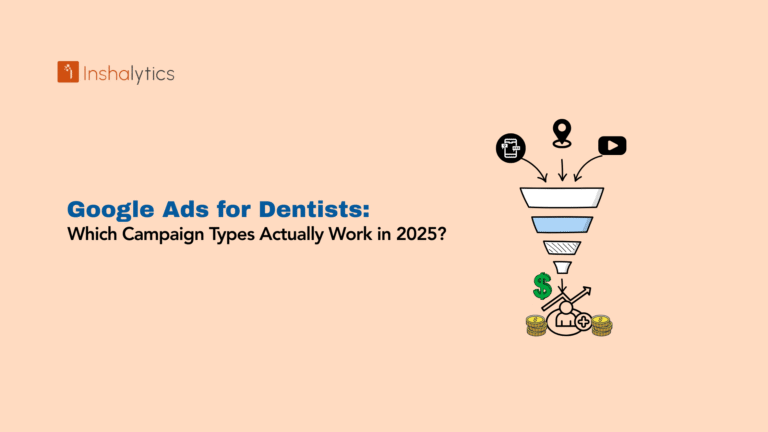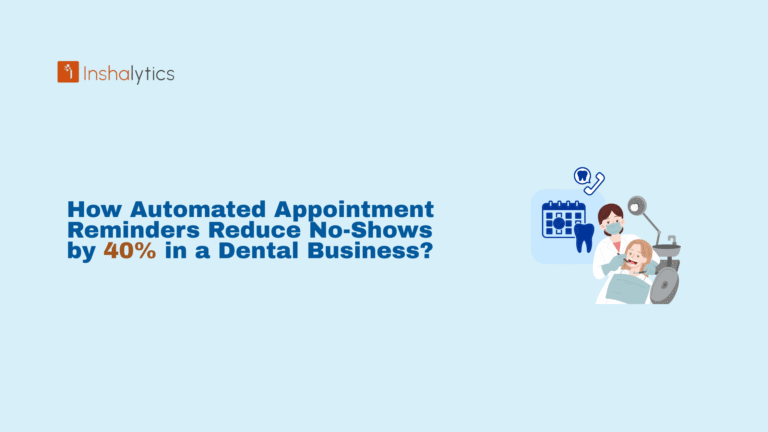It’s 2 AM, and a worried parent is awake, phone in hand, frantically searching “pediatric dentist near me” because their toddler is crying with tooth pain. In that moment, will your practice appear in their search results? Will your website reassure them that you understand their anxiety and can help their child?
The landscape of pediatric dentistry marketing has fundamentally changed. Modern parents—primarily millennials navigating the challenges of raising young children—don’t flip through phone books or rely solely on word-of-mouth recommendations anymore. They conduct extensive online research, read dozens of reviews, scroll through Instagram feeds, and ask for advice in Facebook mom groups before making healthcare decisions for their kids.
This shift presents both a challenge and an unprecedented opportunity for pediatric dental practices. The parents searching for your services are doing so with urgency, emotion, and high expectations. They want a dentist who understands childhood dental anxiety, creates a welcoming environment, and communicates clearly about treatment options. But first, they need to find you.
This comprehensive guide reveals proven strategies to position your pediatric dental practice exactly where parents are searching—from Google’s local pack to social media platforms, from community events to educational content that builds trust before families ever walk through your door.
Understanding Your Target Audience: Millennial Parents
Today’s parents approach healthcare decisions with a completely different mindset than previous generations. They’re digital natives who expect instant access to information, transparent communication, and social proof before committing to any healthcare provider for their children.
How Modern Parents Search for Pediatric Dentists?
Parents typically begin their search journey with highly specific, location-based queries that reveal their underlying concerns. They’re not just typing “dentist”—they’re searching for “gentle dentist for anxious children in Brooklyn,” or “pediatric dentist accepting Medicaid near me,” or “kid-friendly dental office with Saturday appointments.”
This search behavior is crucial to understand because it reveals both practical needs and emotional context. A parent searching for a “gentle” or “patient” dentist is signaling that their child has dental anxiety or perhaps had a negative experience elsewhere. Someone looking for weekend availability is juggling work schedules. These nuances should inform both your SEO strategy and your messaging.
The modern parent’s research process is remarkably thorough. Studies show the average parent reads at least seven online reviews before choosing a pediatric dentist. They check your Google Business Profile rating, scroll through months of Instagram posts to gauge your practice’s atmosphere, read your website’s “About” page to understand your philosophy, and often post in local parenting Facebook groups asking, “Has anyone taken their kids to Dr. Smith’s office? What was your experience?”
This multi-platform research journey means your marketing can’t live in just one place. You need a cohesive presence across every channel where parents spend time, with consistent messaging that reinforces your practice’s core values and differentiators.
Parent Search Behavior and Intent Signals
Voice search is fundamentally reshaping how parents discover pediatric dentists. Instead of typing fragmented keywords, they’re asking complete questions: “Alexa, where’s the best dentist for kids near me that takes my insurance?” or “Hey Siri, find a pediatric dentist open on Saturday who’s good with toddlers.”
Your content strategy must evolve to address these conversational, question-based queries. This means creating FAQ content, optimizing for long-tail keywords, and structuring your website with clear answers to common parent questions. When you naturally incorporate phrases like “we’re experienced with anxious children” or “we offer early morning and weekend appointments,” you’re more likely to appear in these voice search results.
Parents also move through distinct phases of search intent. Some are in early research mode, months before they need an appointment, looking for educational content about topics like “when should my baby first see a dentist” or “are dental x-rays safe for toddlers.” Others have immediate, high-intent needs: their child broke a tooth, developed a painful cavity, or needs emergency dental care right now.
Your marketing strategy should address both audiences. Educational blog content captures the research-phase parents and builds trust over time. Clear service pages with prominent “Book Now” buttons and phone numbers convert high-intent searchers who are ready to schedule immediately.
Local SEO Strategies for Pediatric Dental Practices
For pediatric dental practices, local SEO isn’t just important—it’s everything. Unlike services that patients might travel for, parents want convenient, nearby dental care. When they search for pediatric dentists, they’re almost exclusively looking for providers within a 5-10 mile radius of their home or their child’s school.
Optimizing Google Business Profile for Local Visibility
Your Google Business Profile (formerly Google My Business) is arguably your most valuable marketing asset. For many parents, it’s their first interaction with your practice, appearing prominently in Google Maps and local search results before they ever visit your website.
Start with the fundamentals: ensure every detail is 100% accurate and complete. Your practice name, address, phone number (NAP), website URL, business hours, and accepted insurance plans must be correct and consistent across every online directory. Even small discrepancies—like “Street” versus “St.”—can confuse search engines and hurt your rankings.
Select the most specific business categories available. Choose “Pediatric Dentist” as your primary category rather than just “Dentist.” Add secondary categories like “Children’s Health Clinic” or “Dental Clinic” to appear in more search variations.
Photos are critically important on your Google Business Profile. Practices with photos receive 42% more requests for driving directions and 35% more clicks to their websites. Upload high-quality images at least weekly: show your colorful, child-friendly waiting room with toys and books, introduce each team member with professional headshots, capture (with permission) genuine moments of happy kids during their visits, and photograph special features like private treatment rooms or the treasure chest kids choose from after appointments.
These visuals help anxious parents envision what their child’s experience will be like, reducing fear and building confidence before they even call.
Create Google Posts at least twice weekly. These mini-updates appear directly in your business profile and can showcase dental health tips, announce special events like back-to-school checkup specials, highlight patient success stories, or share practice updates. Posts keep your profile active and provide fresh content that can appear in local search results.
“Near Me” Search Optimization for Pediatric Dentists
“Near me” searches have exploded, increasing by over 500% in recent years. Parents searching on mobile devices while at the playground, driving home from school pickup, or waiting at soccer practice expect immediate, locally relevant results.
To capture these valuable searches, embed location information throughout your website naturally. Don’t just mention your city once on a contact page—weave your location into page titles, headings, and content. For example, “Our pediatric dental practice has served families in Austin, Texas for over 15 years” or “Conveniently located near the Lakeview Elementary School district.”
If you serve multiple neighborhoods or nearby cities, create individual location pages for each area. Each page needs unique, valuable content—not duplicate text with just the city name swapped out. Include specific information about that community: mention nearby schools, parks, and landmarks, provide detailed driving directions from different parts of town, highlight any community involvement or sponsorships in that area, and feature testimonials from families in that neighborhood.
This hyperlocal approach helps you rank for searches like “pediatric dentist in Riverside,” “kids dentist near Highland Park,” and “children’s dental care in Mesa” simultaneously.
Structure your website with local schema markup—code that helps search engines understand your location, hours, services, and contact information. This technical SEO element makes you eligible for enhanced search features like the local pack, knowledge panels, and rich results.
Managing Online Reviews and Reputation
In pediatric dentistry, reviews are more than marketing—they’re social currency. Parents trust other parents’ experiences more than any advertisement or website copy you could write. A practice with dozens of detailed, positive reviews dramatically outperforms competitors with higher technical skills but fewer testimonials.
Implement a systematic approach to generating reviews. Train your front desk team to identify exceptionally positive visits—when a formerly anxious child leaves smiling, when a parent expresses gratitude for your gentle approach, when a difficult procedure goes smoothly. In these moments, ask: “We’re so glad Emma had such a positive experience today! Would you be willing to share that experience in a Google review? It really helps other parents find us.”
Make leaving reviews easy. Send follow-up emails after appointments with direct links to your Google Business Profile, provide simple instructions for leaving reviews on multiple platforms, and consider offering a small incentive like entry into a monthly drawing (check local regulations regarding review incentives).
Respond to every single review—positive and negative—within 24 hours. For positive reviews, express genuine gratitude and mention specific details they shared: “Thank you so much, Jennifer! We’re thrilled that Marcus felt comfortable during his first cleaning. Our team works hard to create a positive experience for every child, and it means the world when parents like you take time to share that.”
Negative reviews require extra care and professionalism. Never argue, make excuses, or become defensive. Instead, acknowledge the parent’s concerns, apologize for their experience, and invite them to discuss the situation privately: “We’re truly sorry to hear about your experience, and this doesn’t reflect the level of care we strive to provide. Please call our office manager directly at [number] so we can understand what happened and make this right.”
Future parents reading reviews will judge your practice not just on the complaint itself, but on how you responded. A thoughtful, professional response to criticism can actually build trust and demonstrate your commitment to patient satisfaction.
Digital Marketing Channels That Convert Parents
A multi-channel digital marketing strategy ensures you reach parents wherever they spend time online. Each platform serves a distinct purpose in your overall marketing ecosystem, from building brand awareness to directly driving appointment bookings.
Social Media Marketing for Pediatric Practices
Social media offers unprecedented opportunities to showcase your practice’s personality, build relationships with families before they visit, and create a community around children’s dental health.
Instagram Strategies: Reels and Visual Content
Instagram’s algorithm currently prioritizes short-form video content, making Reels essential for organic visibility. Create engaging 15-30 second videos that entertain while educating: show your team doing a silly dance to celebrate Cavity-Free Month, demonstrate proper brushing techniques with oversized toothbrushes and models, introduce team members with quick “Day in the Life” clips, or share before-and-after transformations of anxious kids who left smiling.
Use trending audio tracks strategically. When you pair dental health content with popular sounds, you dramatically increase discoverability beyond your existing followers. But ensure the content remains professional and relevant—trending doesn’t mean losing your brand identity.
Post to your main feed consistently with high-quality, visually appealing images. Showcase the fun, colorful aspects that make your practice welcoming: your themed treatment rooms (underwater world, outer space, jungle safari), the treasure chest kids choose from after brave appointments, team members wearing silly hats or colorful scrubs, and patient success stories with permission from families.
Feature real patients and families whenever possible. Authentic content performs better than stock photography and helps prospective patients envision their own children in your care. Always obtain proper consent and photo releases, especially when featuring minors.
Use hashtags strategically but don’t overdo it. Combine popular local hashtags (#ChicagoMoms, #AustinKids) with pediatric dentistry-specific tags (#PediatricDentist, #KidsDentist, #ChildrensDentalHealth) and niche tags that target specific concerns (#DentalAnxiety, #FirstDentalVisit). Research which hashtags your target audience actually follows rather than just using the most popular tags.
Facebook Mom Groups and Community Engagement
Facebook remains a powerhouse for reaching parents, particularly through local community groups where moms actively seek recommendations and advice. Join neighborhood groups, school parent associations, city-wide parenting communities, and family-focused local pages.
However, approach these spaces with authentic engagement, not aggressive self-promotion. Immediately posting advertisements will get you banned from most groups and damage your reputation. Instead, become a genuinely helpful member of the community.
Answer dental health questions thoughtfully when they arise: “My 2-year-old refuses to let me brush her teeth. Any tips?” is an opportunity to share professional advice without selling. Offer tips for managing teething pain, explain when baby teeth typically fall out, or provide guidance about preparing children for their first dental visit.
Build relationships first. When you consistently provide value and demonstrate expertise over weeks and months, group members will remember you. Then, when someone posts “Can anyone recommend a great pediatric dentist?”, the parents you’ve helped will enthusiastically tag your practice and share their positive experiences.
Create your own Facebook page for your practice and post regularly. Share educational content, celebrate patient milestones (with permission), introduce team members, and highlight community involvement. Encourage patients to check in when they visit and tag your page in their posts.
Pinterest Marketing for Parenting Demographics
Pinterest functions as a visual search engine where parents actively seek solutions, ideas, and inspiration. The platform is particularly effective for reaching mothers, who make up over 60% of users and frequently search for parenting and health-related content.
Create boards featuring diverse topics related to children’s dental health: “Dental Health Tips for Kids,” “Overcoming Dental Anxiety,” “Tooth Fairy Ideas and Traditions,” “Healthy Snacks for Strong Teeth,” “Fun Ways to Teach Kids to Brush,” and “Preparing for Your Child’s First Dentist Visit.”
Design eye-catching, vertical graphics (ideal size: 1000×1500 pixels) with clear, readable text overlays. Pinterest is a visual platform, so invest in creating attractive, shareable content. Each pin should link back to relevant blog posts or service pages on your website, driving traffic and establishing your expertise.
Pinterest content has remarkable longevity. Unlike Instagram posts that disappear from feeds within hours, pins can continue generating traffic for months or even years. This makes it excellent for evergreen content about topics like proper brushing techniques, understanding baby teeth development, or recognizing signs of cavities.
Use keyword-rich descriptions for every pin. Parents search Pinterest like Google, typing queries like “how to stop thumb sucking” or “when do kids lose baby teeth.” Incorporate these search terms naturally in your pin descriptions to improve discoverability.
Content Marketing That Builds Trust
Content marketing establishes your practice as the authoritative, trustworthy resource for pediatric dental information in your community. When parents have questions about their child’s oral health, your website should provide clear, accessible, expert answers.
Educational Blog Topics Parents Search For
Create blog content that directly addresses the questions keeping parents awake at night. Target long-tail keywords and specific concerns rather than broad topics: “When should my child have their first dental visit?” answers a common question and ranks better than a generic post about “Pediatric Dentistry.”
High-value blog topics include preparing toddlers for their first dentist appointment, managing dental anxiety in children, understanding baby teeth development timelines, deciding when braces are necessary, handling dental emergencies like knocked-out teeth, choosing the right toothbrush and toothpaste for different ages, and explaining common procedures like dental sealants or fluoride treatments.
Structure blog posts for easy scanning. Use descriptive headings and subheadings, incorporate bullet points and numbered lists, keep paragraphs short (3-4 sentences maximum), include relevant images or infographics, and bold key takeaways or important information.
Busy parents often skim content looking for quick answers, so make critical information easy to find. Include a brief summary or key points at the beginning of longer articles.
End every blog post with a clear call-to-action. Encourage readers to schedule appointments, call with questions, download a helpful checklist, or sign up for your email newsletter. Don’t assume readers will know what to do next—tell them explicitly.
Optimize each post for one primary keyword or question. Research what parents actually search using tools like Google’s “People Also Ask” feature, answer the specific question comprehensively, include the keyword naturally in your title and headings, and add related questions and topics to provide thorough coverage.
Video Marketing: Virtual Tours and Patient Testimonials
Video content generates significantly higher engagement than text or static images across all platforms. Parents want to see your practice, meet your team, and understand what their child’s experience will be like before scheduling an appointment.
Create comprehensive virtual office tours that walk parents through the entire visit process. Start in the parking lot, show the entrance and waiting area with toys and books, introduce the front desk team and explain check-in procedures, display treatment rooms and explain the equipment in child-friendly terms, highlight special features like TVs on the ceiling or headphones for music, and show where kids choose prizes after appointments.
This transparency reduces anxiety by eliminating the fear of the unknown. When a child knows they’ll walk into a colorful, fun space with friendly people and cool toys, they’re much less likely to be scared.
Patient testimonial videos are incredibly powerful for building trust. Seeing real parents sharing genuine experiences creates emotional connections that written reviews can’t match. Ask families who’ve had particularly positive experiences if they’d be willing to share their story on camera.
Keep testimonial videos authentic and unscripted. Parents can immediately detect fake or overly polished content. Instead, ask simple questions and let families respond naturally: What was your biggest concern before visiting us? How did we help your child feel comfortable? What would you tell other parents considering our practice?
Feature diverse families in your videos. Prospective patients want to see people who look like them and share similar concerns. Include families with children of different ages, various ethnic backgrounds, and diverse experiences (first visits, children with special needs, overcoming severe anxiety).
Post videos across multiple platforms: upload to YouTube for search visibility and long-term hosting, share on Facebook and Instagram for immediate engagement, embed on relevant website pages, and include in email newsletters.
Optimize YouTube videos with keyword-rich titles and descriptions, add relevant tags, include timestamps for different sections, and add captions for accessibility.
Email Marketing and Appointment Reminders
Email marketing maintains relationships with existing patients while nurturing prospective patients who aren’t ready to book immediately. It’s one of the highest ROI marketing channels when executed strategically.
Segment your email list to send targeted, relevant messages. Create different segments for current patients, prospective patients who filled out contact forms but didn’t schedule, parents of children in different age groups (toddlers vs. teens need different information), and patients due for their next checkup or overdue for appointments.
Send age-appropriate milestone reminders based on children’s birthdates. A six-month-old needs information about teething and when to expect their first tooth. A six-year-old’s family should learn about losing baby teeth and permanent tooth care. Automated email sequences can deliver this valuable, timely content without manual effort.
Provide genuine value in every email, not just promotional messages. Share seasonal dental health tips, updates about your practice, spotlights on team members, summaries of recent blog posts with links to read more, reminders about important dental milestones, and invitations to special events or community activities.
When emails consistently provide helpful information, parents will actually look forward to receiving them rather than immediately deleting or unsubscribing.
Create automated appointment reminder sequences. Send an initial reminder two weeks before scheduled appointments, a second reminder one week out, a final reminder via text and email 24 hours before, and a follow-up after appointments thanking them for visiting.
Appointment reminders dramatically reduce no-shows, which protects your schedule and revenue. They also provide opportunities to encourage rescheduling if conflicts arise, maximizing your appointment book efficiency.
Ground Marketing: Connecting With Families in Person
While digital marketing dominates modern strategies, face-to-face community engagement remains incredibly effective for pediatric dental practices. Ground marketing builds local relationships, generates word-of-mouth referrals, and establishes your practice as an integral part of the community.
Strategic Locations for Pediatric Dental Marketing
The key to successful ground marketing is being present where your target audience already gathers. Parents with young children frequent specific locations regularly, creating consistent opportunities for meaningful engagement.
Partnering With Daycare Centers and Preschools
Daycare centers and preschools are goldmines for pediatric dental practices. They’re open year-round, parents visit daily for drop-off and pickup, and you can immediately gauge the socioeconomic demographics of your target market.
Approach daycare directors with a value proposition that benefits their facility and families, not just your practice. Offer to conduct age-appropriate dental health presentations for the children, provide free dental education materials for parents, sponsor events or field trips, or host “Dentist for a Day” activities where kids learn about oral health through fun, interactive experiences.
Timing is critical for ground marketing at daycares. Be present during pickup times between 3 PM and 6 PM when parents arrive. Set up an information booth near the entrance with branded materials, toothbrushes and floss for kids, and simple freebies like stickers or coloring books.
Your goal is to connect with parents, not just children. While kids are attracted to the fun freebies, engage their parents in brief conversations: introduce yourself and your practice, share your proximity to their location, mention your hours and insurance acceptance, and provide business cards or refrigerator magnets with your contact information.
Build ongoing relationships with daycare administrators. Become their go-to resource for dental health questions and their first referral when parents ask for pediatric dentist recommendations.
Children’s Retail Stores and Activity Centers
Children’s clothing stores, toy stores, Build-A-Bear locations, Color Me Mine pottery studios, and indoor playground facilities attract your exact target demographic: parents actively spending time and money on their children.
Approach store managers with partnership proposals. Offer to sponsor events, provide coupons or gift certificates for their customers, cross-promote each other’s businesses on social media, or host joint community events like “Paint & Learn About Dental Health” nights.
Many children’s retailers host regular events—birthday parties, craft activities, seasonal celebrations. Ask to participate by setting up information tables, providing branded giveaways, or offering mini dental health education sessions.
The key is providing value to both the retailer and their customers. You’re not just promoting your practice; you’re enhancing the overall experience and showing genuine community involvement.
School Events and Community Engagement
Partner with local elementary schools for health fairs, career days, and educational presentations. Many schools welcome healthcare professionals who can teach children about wellness topics in engaging, age-appropriate ways.
Create interactive dental health presentations for different grade levels. For younger children, use puppets, oversized toothbrushes, and tooth models to demonstrate proper brushing. For older elementary students, discuss topics like sugary drinks’ effects on teeth, the importance of wearing mouthguards for sports, and what orthodontic braces do.
Sponsor school events, sports teams, or fundraisers. Your practice logo on t-shirts, banners at school plays, or mentions in event programs keeps your name visible to hundreds of local families.
Provide free dental screenings at school health fairs. Parents appreciate convenient access to preventive care, and you can identify potential issues while building relationships with new families.
Creating Parent-Focused Events and Experiences
Host community events at your practice that position you as a family-friendly, welcoming destination beyond just dental appointments. Open houses allow families to tour your facility in a low-pressure environment, meet your team informally, ask questions about pediatric dental care, and let children explore treatment rooms and equipment.
Schedule events around relevant holidays or awareness months: February (Children’s Dental Health Month), Halloween (candy buyback programs), back-to-school season, or summer vacation periods.
Organize educational workshops for parents on topics like managing dental anxiety, understanding dental insurance and payment options, nutrition for healthy teeth, or preparing children for orthodontic treatment.
These events establish your expertise while providing genuine value to the community, creating positive associations with your practice before families ever need dental services.
Website Optimization for Parent Conversion
Your website is often the deciding factor between a parent calling to schedule or moving on to a competitor. It must be more than attractive—it needs to be strategically designed to convert visitors into patients.
Mobile-First Design for Busy Parents
Over 60% of parents search for healthcare providers on mobile devices. Your website must provide an excellent mobile experience, loading quickly (under 3 seconds), displaying properly on screens of all sizes, featuring easily tappable buttons and phone numbers, and allowing simple navigation without excessive scrolling or zooming.
Google now uses mobile-first indexing, meaning your mobile site’s performance directly impacts your search rankings. A slow, difficult-to-use mobile site hurts both user experience and SEO.
Building a Child-Friendly Online Experience
While parents make the decisions, your website should also appeal to young visitors. Use bright, welcoming colors and cheerful imagery, include fun illustrations or animations, feature photos of real children smiling and comfortable in your office, and avoid clinical, sterile imagery that increases anxiety.
Consider adding a “Just for Kids” section with games, coloring pages, or educational videos that make dental health fun.
Clear Calls-to-Action and Online Booking
Every page should have prominent, obvious calls-to-action telling visitors exactly what to do next. Place “Schedule an Appointment” buttons in the header and footer, display your phone number prominently at the top of every page, offer online booking through an easy-to-use scheduling system, and provide multiple contact options (phone, form, chat, email).
Remove friction from the scheduling process. Each additional step or required form field reduces the likelihood of conversion. Make booking as simple as possible.
Measuring Marketing Success and ROI
Marketing without measurement is guesswork. Track specific metrics to understand what’s working, what needs improvement, and where to invest additional resources.
Key Performance Indicators for Pediatric Practices
Monitor website traffic and sources, new patient appointments attributed to marketing channels, online review quantity and average rating, social media engagement and follower growth, email open rates and click-through rates, phone call volume and sources, and Google Business Profile views and actions taken.
Use tools like Google Analytics, call tracking software, and practice management system reports to gather this data consistently.
Tracking New Patient Acquisition Costs
Calculate how much you spend to acquire each new patient across different marketing channels. Divide total marketing investment by new patients acquired to understand your cost per acquisition. Compare this to patient lifetime value to ensure positive ROI.
This data reveals which marketing efforts provide the best return, allowing you to allocate budget more effectively.
Patient Retention and Lifetime Value Metrics
Acquiring new patients is important, but retaining them is more profitable. Track appointment completion rates, recall appointment scheduling and attendance, average treatment acceptance rates, and patient referrals generated.
Happy, loyal patients become your most effective marketers through word-of-mouth recommendations and positive online reviews. Focus as much on retention and experience as on acquisition.
Conclusion
Successful pediatric dentistry marketing requires a comprehensive, multi-channel strategy that meets parents where they search—online and offline, digital and face-to-face. By optimizing your local SEO, creating valuable content, engaging authentically on social media, building community relationships, and measuring your results consistently, you’ll position your practice as the trusted choice for families seeking exceptional children’s dental care.
The parents searching for pediatric dentists right now need what you offer. Your marketing’s job is simply to ensure they find you, trust you, and choose you for their children’s dental health journey.




